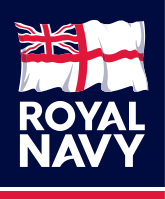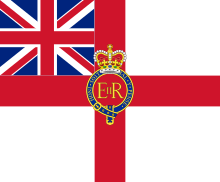Royal Navy
The Royal Navy (RN) is the United Kingdom's naval warfare force. Although warships were used by the English kings from the early medieval period, the first major maritime engagements were fought in the Hundred Years' War against the Kingdom of France. The modern Royal Navy traces its origins to the early 16th century; the oldest of the UK's armed services, it is known as the Senior Service.
 |
| Her Majesty's Naval Service of the British Armed Forces |
|---|
| Components |
|
|
| History and future |
| Ships |
| Personnel |
|
|
| Auxiliary services |
From the middle decades of the 17th century, and through the 18th century, the Royal Navy vied with the Dutch Navy and later with the French Navy for maritime supremacy. From the mid 18th century, it was the world's most powerful navy until the Second World War. The Royal Navy played a key part in establishing the British Empire as the unmatched world power during the 19th and first part of the 20th centuries. Due to this historical prominence, it is common, even among non-Britons, to refer to it as "the Royal Navy" without qualification.
Following World War I, the Royal Navy was significantly reduced in size,[5] although at the onset of World War II it was still the world's largest. During the Cold War, the Royal Navy transformed into a primarily anti-submarine force, hunting for Soviet submarines and mostly active in the GIUK gap. Following the collapse of the Soviet Union, its focus has returned to expeditionary operations around the world and it remains one of the world's foremost blue-water navies.[6][7][8] However, 21st-century reductions in naval spending have led to a personnel shortage and a reduction in the number of warships.[9][10]
The Royal Navy maintains a fleet of technologically sophisticated ships, submarines, and aircraft, including two aircraft carriers, two amphibious transport docks, four ballistic missile submarines (which maintain the UK's nuclear deterrent), seven nuclear fleet submarines, six guided missile destroyers, 13 frigates, 13 mine-countermeasure vessels and 23 patrol vessels. As of August 2020, there are 77 operational commissioned ships (including submarines as well as two "static ships") in the Royal Navy, plus 13 ships of the Royal Fleet Auxiliary (RFA); there are also five Merchant Navy ships available to the RFA under a private finance initiative. The RFA replenishes Royal Navy warships at sea, and augments the Royal Navy's amphibious warfare capabilities through its three Bay-class landing ship vessels. It also works as a force multiplier for the Royal Navy, often doing patrols that frigates used to do. The total displacement of the Royal Navy is approximately 450,300 tonnes (826,300 tonnes including the Royal Fleet Auxiliary).
The Royal Navy is part of Her Majesty's Naval Service, which also includes the Royal Marines. The professional head of the Naval Service is the First Sea Lord who is an admiral and member of the Defence Council of the United Kingdom. The Defence Council delegates management of the Naval Service to the Admiralty Board, chaired by the Secretary of State for Defence. The Royal Navy operates from three bases in the United Kingdom where commissioned ships and submarines are based: Portsmouth, Clyde and Devonport, the last being the largest operational naval base in Western Europe, as well as two naval air stations, RNAS Yeovilton and RNAS Culdrose where maritime aircraft are based.
Role
As the seaborne branch of HM Armed Forces, the RN has various roles. As it stands today, the RN has stated its 6 major roles as detailed below in umbrella terms.[11]
- Preventing Conflict – On a global and regional level
- Providing Security At Sea – To ensure the stability of international trade at sea
- International Partnerships – To help cement the relationship with the United Kingdom's allies (such as NATO)
- Maintaining a Readiness To Fight – To protect the United Kingdom's interests across the globe
- Protecting the Economy – To safeguard vital trade routes to guarantee the United Kingdom's and its allies' economic prosperity at sea
- Providing Humanitarian Aid – To deliver a fast and effective response to global catastrophes
History
The Royal Navy was formally founded in 1546 by Henry VIII[12] though the Kingdom of England and its predecessor states had possessed less organised naval forces for centuries prior to this.[13]
Earlier fleets
During much of the medieval period, fleets or "king's ships" were often established or gathered for specific campaigns or actions, and these would disperse afterwards. These were generally merchant ships enlisted into service. Unlike some European states, England did not maintain a small permanent core of warships in peacetime. England's naval organisation was haphazard and the mobilization of fleets when war broke out was slow.[14] In the 11th century, Aethelred II had an especially large fleet built by a national levy.[15] During the period of Danish rule in the 11th century, the authorities maintained a standing fleet by taxation, and this continued for a time under Edward the Confessor, who frequently commanded fleets in person.[16] After the Norman Conquest, English naval power waned and England suffered naval raids from the Vikings.[17] In 1069, this allowed for the invasion and ravaging of England by Jarl Osborn (brother of King Svein Estridsson) and his sons.[18]
The lack of an organised navy came to a head during the Baron's Revolt, in which Dauphin Louis invaded England in support of northern barons. With King John unable to organise a navy, this meant the French landed at Sandwich unopposed in April 1216. John's flight to Winchester and his death later that year left the Earl of Pembroke as regent, and he was able to marshal ships to fight the French in the Battle of Sandwich in 1217- one of the first major English battles at sea.[19] The outbreak of the Hundred Years War emphasised the need for an English fleet. French plans for an invasion of England failed when Edward III of England destroyed the French fleet in the Battle of Sluys in 1340.[20] England's naval forces could not prevent frequent raids on the south-coast ports by the French and their allies. Such raids halted only with the occupation of northern France by Henry V.[21] A Scottish fleet existed by the reign of William the Lion.[22] In the early 13th century there was a resurgence of Viking naval power in the region. The Vikings clashed with Scotland over control of the isles[23] though Alexander III was ultimately successful in asserting Scottish control.[24] The Scottish fleet was of particular import in repulsing English forces in the early 14th century.[25]

Age of Sail
A standing "Navy Royal",[26] with its own secretariat, dockyards and a permanent core of purpose-built warships, emerged during the reign of Henry VIII.[27] Under Elizabeth I England became involved in a war with Spain, which saw privately owned vessels combining with the Queen's ships in highly profitable raids against Spanish commerce and colonies.[28] The Royal Navy was then used in 1588 to repulse the Spanish Armada. In 1603, the Union of the Crowns created a personal union between England and Scotland. While the two remained distinct sovereign states for a further century, the two navies increasingly fought as a single force. During the early 17th century, England's relative naval power deteriorated until Charles I undertook a major programme of shipbuilding. His methods of financing the fleet however contributed to the outbreak of the English Civil War, and the abolition of the monarchy.[29]
The Commonwealth of England replaced many names and symbols in the new commonwealth navy, associated with royalty and the high church, and expanded it to become the most powerful in the world.[30][31] The fleet was quickly tested in the First Anglo-Dutch War (1652–1654) and the Anglo-Spanish War (1654-1660), which saw the conquest of Jamaica and successful attacks on Spanish treasure fleets. The 1660 Restoration saw Charles II rename the Royal Navy again, and started use of the prefix HMS. The navy however remained a national institution and not a possession of the crown as it had been before.[32] Following the Glorious Revolution of 1688, England joined the War of the Grand Alliance which marked the end of France's brief pre-eminence at sea and the beginning of an enduring British supremacy.[33]

In 1707, the United Kingdom was formed by the Act of Union, which had the effect of merging the Scottish navy into the Royal Navy. Throughout the 18th and 19th centuries, the Royal Navy was the largest maritime force in the world,[34] maintaining superiority in financing, tactics, training, organisation, social cohesion, hygiene, logistical support and warship design.[35] The peace settlement following the War of the Spanish Succession (1702–1714) granted Britain Gibraltar and Menorca, providing the Navy with Mediterranean bases. A new French attempt to invade Britain was thwarted by the defeat of their escort fleet in the extraordinary Battle of Quiberon Bay in 1759, fought in dangerous conditions.[36] In 1762 the resumption of hostilities with Spain led to the British capture of Manila and of Havana, along with a Spanish fleet sheltering there.[37] British naval supremacy could however be challenged still in this period by coalitions of other nations, as seen in the American War of Independence. Rebel colonists were supported by France, Spain and the Netherlands against Britain. In the Battle of the Chesapeake, the British fleet failed to lift the French blockade, resulting in Cornwallis's surrender at Yorktown.[38] The French Revolutionary Wars (1793–1801) and Napoleonic Wars (1803–1814 & 1815) saw the Royal Navy reach a peak of efficiency, dominating the navies of all Britain's adversaries, which spent most of the war blockaded in port. Under Admiral Nelson, the navy defeated the combined Franco-Spanish fleet at Trafalgar (1805).[39]
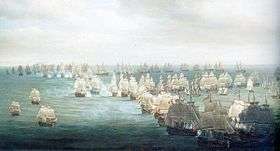
Between 1815 and 1914, the Navy saw little serious action, owing to the absence of any opponent strong enough to challenge its dominance. During this period, naval warfare underwent a comprehensive transformation, brought about by steam propulsion, metal ship construction, and explosive munitions. Despite having to completely replace its war fleet, the Navy managed to maintain its overwhelming advantage over all potential rivals. Due to British leadership in the Industrial Revolution, the country enjoyed unparalleled shipbuilding capacity and financial resources, which ensured that no rival could take advantage of these revolutionary changes to negate the British advantage in ship numbers.[40] In 1889, Parliament passed the Naval Defence Act, which formally adopted the 'two-power standard', which stipulated that the Royal Navy should maintain a number of battleships at least equal to the combined strength of the next two largest navies.[41] The end of the 19th century saw structural changes and older vessels were scrapped or placed into reserve, making funds and manpower available for newer ships. The launch of HMS Dreadnought in 1906 rendered all existing battleships obsolete.[42]
World Wars
During the First World War, the Royal Navy's strength was mostly deployed at home in the Grand Fleet, confronting the German High Seas Fleet across the North Sea. Several inconclusive clashes took place between them, chiefly the Battle of Jutland in 1916. The British numerical advantage proved insurmountable, leading the High Seas Fleet to abandon any attempt to challenge British dominance.[43] In the inter-war period, the Royal Navy was stripped of much of its power. The Washington and London Naval Treaties imposed the scrapping of some capital ships and limitations on new construction.[44] In 1932, the Invergordon Mutiny took place over a proposed 25% pay cut, which was eventually reduced to 10%.[45] International tensions increased in the mid-1930s and the re-armament of the Royal Navy was well under way by 1938. In addition to new construction, several existing old battleships, battlecruisers and heavy cruisers were reconstructed, and anti-aircraft weaponry reinforced, while new technologies, such as ASDIC, Huff-Duff and hydrophones, were developed.[46]
At the start of World War II in 1939, the Royal Navy was the largest in the world, with over 1,400 vessels[47][48] The Royal Navy provided critical cover during Operation Dynamo, the British evacuations from Dunkirk, and as the ultimate deterrent to a German invasion of Britain during the following four months. At Taranto, Admiral Cunningham commanded a fleet that launched the first all-aircraft naval attack in history. The Royal Navy suffered heavy losses in the first two years of the war. Over 3,000 people were lost when the converted troopship Lancastria was sunk in June 1940, the greatest maritime disaster in Britain's history.[49] The Navy's most critical struggle was the Battle of the Atlantic defending Britain's vital commercial supply lines against U-boat attack. A traditional convoy system was instituted from the start of the war, but German submarine tactics, based on group attacks by "wolf-packs", were much more effective than in the previous war, and the threat remained serious for well over three years.[50]
Since 1945
After the Second World War, the decline of the British Empire and the economic hardships in Britain forced the reduction in the size and capability of the Royal Navy. The United States Navy instead took on the role of global naval power. Governments since have faced increasing budgetary pressures, partly due to the increasing cost of weapons systems.[51] In 1981, Defence Secretary John Nott had advocated and initiated a series of cutbacks to the Navy.[52] The Falklands War however proved a need for the Royal Navy to regain an expeditionary and littoral capability which, with its resources and structure at the time, would prove difficult. At the beginning of the 1980s, the Royal Navy was a force focused on blue-water anti-submarine warfare. Its purpose was to search for and destroy Soviet submarines in the North Atlantic, and to operate the nuclear deterrent submarine force. The navy received its first nuclear weapons with the introduction of the first of the Resolution-class submarines armed with the Polaris missile. By the 1990s, the navy became responsible for the maintenance of the UK's entire nuclear arsenal. The financial costs attached to nuclear deterrence became an increasingly significant issue for the navy.[53] New and more capable ships were built; notably the Sheffield-class destroyers, the Type 21, Type 22, and Type 23 frigates, new LPDs of the Albion class, and HMS Ocean, but never in the numbers of the ships that they replaced. As a result, the Royal Navy surface fleet continues to reduce in size. A 2013 report found that the current RN was already too small, and that Britain would have to depend on her allies if her territories were attacked.[54]
Royal Navy today
Personnel
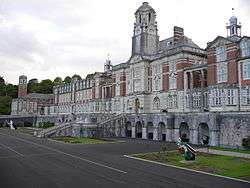
HMS Raleigh at Torpoint, Cornwall, is the basic training facility for newly enlisted ratings. Britannia Royal Naval College is the initial officer training establishment for the navy, located at Dartmouth, Devon. Personnel are divided into a warfare branch, which includes Warfare Officers (previously named seamen officers) and Naval Aviators,[55] as well other branches including the Royal Naval Engineers, Royal Navy Medical Branch, and Logistics Officers (previously named Supply Officers). Present-day officers and ratings have several different Royal Navy uniforms; some are designed to be worn aboard ship, others ashore or in ceremonial duties. Women began to join the Royal Navy in 1917 with the formation of the Women's Royal Naval Service (WRNS), which was disbanded after the end of the First World War in 1919. It was revived in 1939, and the WRNS continued until disbandment in 1993, as a result of the decision to fully integrate women into the structures of the Royal Navy. Women now serve in all sections of the Royal Navy including the Royal Marines.[56]
By January 2015, the Naval Service (Royal Navy and Royal Marines) numbered some 32,880 Regular[57] and 3,040 Maritime Reserve personnel (Royal Naval Reserve and Royal Marines Reserve),[58] giving a combined component strength of 35,920 personnel. In addition to the active elements of the Naval Service (Regular and Maritime Reserve), all ex-Regular personnel remain liable to be recalled for duty in a time of need, this is known as the Regular Reserve. In 2002, there were 26,520 Regular Reserves of the Naval Service, of which 13,720 served in the Royal Fleet Reserve.[59] Publications since April 2013 no-longer report the entire strength of the Regular Reserve, instead they only give a figure for Regular Reserves who serve in the Royal Fleet Reserve.[60] They had a strength of 7,960 personnel in 2013.[61]
In August 2019, the Ministry of Defence published figures showing that the Royal Navy and Royal Marines had 29,090 full-time trained personnel compared with a target of 30,600.[62]
In December 2019 the First Sea Lord, Admiral Tony Radakin outlined a proposal to reduce the number of Rear-Admirals at Navy Command by five.[63] The fighting arms (excluding Commandant General Royal Marines) would be reduced to Commodore (1-star) rank and the surface flotillas would be combined together. Training would be concentrated under the Fleet Commander.[64]
Surface fleet
_underway_during_trials_with_HMS_Sutherland_(F81)_and_HMS_Iron_Duke_(F234)_on_28_June_2017_(45162784).jpg)
Amphibious warfare
The large fleet units in the Royal Navy consisted of amphibious warfare ships until December 2017, when the first Queen Elizabeth-class carrier was commissioned.[65] Amphibious warfare ships in current service include two landing platform docks (HMS Albion and HMS Bulwark). While their primary role is to conduct amphibious warfare, they have also been deployed for humanitarian aid missions.[66]
Aircraft carriers
The Royal Navy has two Queen Elizabeth-class aircraft carriers, currently undertaking sea and aircraft trials which are both due to enter naval service within the next few years. Each carrier cost £3 billion and displaces 65,000 tonnes (64,000 long tons; 72,000 short tons).[67] The first, HMS Queen Elizabeth commenced flight trials in 2018. Both are intended to operate the STOVL variant of the F-35 Lightning II. Queen Elizabeth began sea trials in June 2017, was commissioned later that year, and will enter service in 2020, while the second, HMS Prince of Wales began sea trials on 22 September 2019, was commissioned in December 2019 and is due to enter service in 2023.[68][69][70][71]
Escort fleet
The escort fleet comprises guided missile destroyers and frigates and is the traditional workhorse of the Navy.[72] As of January 2018 there are six Type 45 destroyers and 13 Type 23 frigates in active service. Among their primary roles is to provide escort for the larger capital ships—protecting them from air, surface and subsurface threats. Other duties include undertaking the Royal Navy's standing deployments across the globe, which often consists of: counter-narcotics, anti-piracy missions and providing humanitarian aid.[66]
.jpg)
All six Type 45 destroyers have been built and are in commission, with HMS Duncan being the last and final Type 45 entering service in September 2013.[73] The new Type 45 destroyers replaced the older Type 42 destroyers. The Type 45 is primarily designed for anti-aircraft and anti-missile warfare and the Royal Navy describe the destroyers mission as "to shield the Fleet from air attack".[74] They are equipped with the PAAMS (also known as Sea Viper) integrated anti-aircraft warfare system which incorporates the sophisticated SAMPSON and S1850M long range radars and the Aster 15 and 30 missiles.[75]

Initially, 16 Type 23 frigates were delivered to the Royal Navy, with the final vessel, HMS St Albans, commissioned in June 2002. However, the 2004 review of defence spending (Delivering Security in a Changing World) announced that three frigates of the fleet of sixteen would be paid off as part of a continuous cost-cutting strategy, and these were subsequently sold to the Chilean Navy.[76] The 2010 Strategic Defence and Security Review announced that the remaining 13 Type 23 frigates would eventually be replaced by the Type 26 Frigate.[77] The Strategic Defence and Security Review 2015 reduced the procurement of Type 26 to eight with five Type 31e frigates to be procured.[78]
Mine Countermeasure Vessels (MCMV)
There are two classes of MCMVs in the Royal Navy: seven Sandown-class minehunters and six Hunt-class mine countermeasures vessels. The Hunt-class vessels combine the separate roles of the traditional minesweeper and the active minehunter in one hull. If required, the Sandown and Hunt-class vessels can take on the role of offshore patrol vessels.[79]
Offshore Patrol Vessels (OPV)
In 1997, three Batch 1 River class ships were procured; unusually, these were owned by Vosper Thorneycroft, and leased to the Royal Navy until 2013. This relationship was defined by a ground-breaking contractor logistic support contract which contracts the ships' availability to the RN, including technical and stores support. In November 2013, it was announced that in order to sustain shipbuilding capabilities on the Clyde, five new ocean-going patrol vessels with Merlin-capable flight decks would be ordered for delivery from 2017. In October 2014, the Ministry of Defence announced the names of the first three ships as HMS Forth, HMS Medway and HMS Trent.[80] The fourth and fifth ships were ordered in December 2016: the fourth named HMS Tamar and the fifth (still under construction) HMS Spey.[81]
In December 2019, the modified ‘Batch 1’ River-class vessel, HMS Clyde, was decommissioned, with the ‘Batch 2’ HMS Forth taking over duties as the Falkland Islands patrol ship.[82][83]
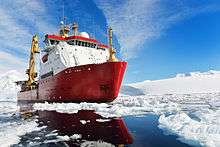
Ocean survey ships
HMS Protector is a dedicated Antarctic patrol ship that fulfils the nation's mandate to provide support to the British Antarctic Survey (BAS).[84]HMS Scott is an ocean survey vessel and at 13,500 tonnes is one of the largest ships in the Navy. The other survey vessels of the Royal Navy are the two multi-role ships of the Echo class, which came into service in 2002 and 2003. As of 2018, the newly commissioned HMS Magpie also undertakes survey duties at sea.[85]
Royal Fleet Auxiliary
The Navy's large fleet units are supported by the Royal Fleet Auxiliary which possesses three amphibious transport docks within its operational craft. These are known as the Bay-class landing ships, of which four were introduced in 2006–2007, but one was sold to the Royal Australian Navy in 2011.[86] In November 2006, the First Sea Lord Admiral Sir Jonathon Band described the Royal Fleet Auxiliary vessels as "a major uplift in the Royal Navy's war fighting capability".[87]
Submarine Service
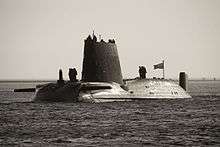
The Submarine Service is the submarine based element of the Royal Navy. It is sometimes referred to as the "Silent Service",[88] as the submarines are generally required to operate undetected. Founded in 1901, the service made history in 1982 when, during the Falklands War, HMS Conqueror became the first nuclear-powered submarine to sink a surface ship, ARA General Belgrano. Today, all of the Royal Navy's submarines are nuclear-powered.[89]
Ballistic Missile Submarines (SSBN)
The Royal Navy operates four Vanguard class ballistic missile submarines displacing nearly 16,000 tonnes and equipped with Trident II missiles (armed with nuclear weapons) and heavyweight Spearfish torpedoes, with the purpose to carry out Operation Relentless, the United Kingdom's Continuous At Sea Deterrent (CASD). In December 2006, the Government published recommendations for a new class of four ballistic missile submarines to replace the current Vanguard class, starting 2024. These new Dreadnought-class submarines will mean that the United Kingdom will maintain a nuclear ballistic missile submarine fleet and the ability to launch nuclear weapons.[90]
Fleet Submarines (SSN)
Six fleet submarines are presently in service, with three Trafalgar class and three Astute class (with the remainder in construction) making up the total. The Trafalgar class displace little over 5,300 tonnes when submerged and are armed with Tomahawk land-attack missiles and Spearfish torpedoes. The Astute class at 7,400 tonnes[91] are much larger and carry a larger number of Tomahawk missiles and Spearfish torpedoes. Four more Astute-class fleet submarines are expected to be commissioned and will eventually replace the remaining Trafalgar-class boats. HMS Artful was the latest Astute-class boat to be commissioned.[92]
In the 2010 Strategic Defence and Security Review, the UK Government reaffirmed its intention to procure seven Astute-class submarines.[93]
Fleet Air Arm
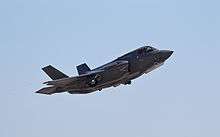
The Fleet Air Arm (FAA) is the branch of the Royal Navy responsible for the operation of naval aircraft, it can trace its roots back to 1912 and the formation of the Royal Flying Corps. The Fleet Air Arm currently comprises: Commando Helicopter Force (operating the AW-101 Merlin HC4 in support of 3 Commando Brigade), Maritime Wildcat Force (operating the AW-159 Wildcat HM2 on small ship's flights), Merlin Force (operating the AW-101 Merlin HM2 in an anti-submarine role) and the newly formed Lightning Force (operating the F-35B Lightning II in the maritime strike role).[94]
Pilots designated for rotary wing service train under No. 1 Flying Training School (1 FTS)[95] at RAF Shawbury.[96]
The FAA is undergoing F-35B (Lightning II) aviation trials on board the new Queen Elizabeth-class aircraft carriers[97] following the retirement of Joint Force Harrier and the Harrier GR7/GR9 strike aircraft in 2010, preparing for front-line operations.[98]
Royal Marines
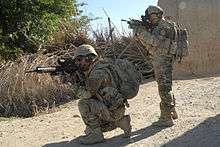
The Royal Marines are an amphibious, specialised light infantry force of commandos, capable of deploying at short notice in support of Her Majesty's Government's military and diplomatic objectives overseas.[99] The Royal Marines are organised into a highly mobile light infantry brigade (3 Commando Brigade) and 7 commando units[100] including 1 Assault Group Royal Marines, 43 Commando Fleet Protection Group Royal Marines and a company strength commitment to the Special Forces Support Group. The Corps operates in all environments and climates, though particular expertise and training is spent on amphibious warfare, Arctic warfare, mountain warfare, expeditionary warfare and commitment to the UK's Rapid Reaction Force. The Royal Marines are also the primary source of personnel for the Special Boat Service (SBS), the Royal Navy's contribution to the United Kingdom Special Forces.[101]
The Royal Marines have seen action in a number of wars, often fighting beside the British Army; including in the Seven Years' War, the Napoleonic Wars, the Crimean War, World War I and World War II. In recent times, the Corps has been deployed in expeditionary warfare roles, such as the Falklands War, the Gulf War, the Bosnian War, the Kosovo War, the Sierra Leone Civil War, the Iraq War and the War in Afghanistan. The Royal Marines have international ties with allied marine forces, particularly the United States Marine Corps[102] and the Netherlands Marine Corps/Korps Mariniers.
Naval bases
The Royal Navy currently uses three major naval port bases in the UK, each housing its own flotilla of ships and boats ready for service along, two naval air stations and a support facility base in Bahrain:
Bases in the United Kingdom
- HMNB Devonport (HMS Drake) – This is currently the largest operational naval base in Western Europe. Devonport's flotilla consists of the RN's two amphibious assault vessels (HM Ships Albion and Bulwark), and half the fleet of Type 23 frigates. Also, Devonport homes some of the RN's Submarines service, including the fleet of Trafalgar-class submarines.[104]
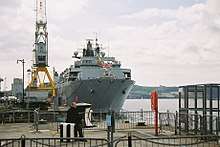
- HMNB Portsmouth (HMS Nelson) – This is home to the future Queen Elizabeth Class supercarriers. Portsmouth is also the home to the Type 45 Daring Class Destroyer and a moderate fleet of Type 23 frigates as well as Fishery Protection Squadrons.[105]
- HMNB Clyde (HMS Neptune) – This is situated in Central Scotland along the River Clyde. Faslane is known as the home of the UK's nuclear deterrent, as it maintains the fleet of Vanguard-class ballistic missile (SSBN) submarines, as well as the fleet of Astute-class fleet (SSN) submarines. By 2020, Faslane will become the home to all Royal Navy submarines, and thus the RN Submarine Service. As a result, 43 Commando (Fleet Protection Group) are stationed in Faslane alongside to guard the base as well as The Royal Naval Armaments Depot at Coulport. Moreover, Faslane is also home to Faslane Patrol Boat Squadron (FPBS) who operates a fleet of Archer class patrol vessels.[106][107]
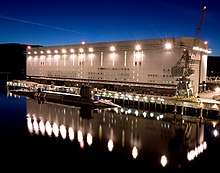
- RNAS Yeovilton (HMS Heron) – Yeovilton is home to Commando Helicopter Force and Wildcat Maritime Force.[108]
.jpg)
- RNAS Culdrose (HMS Seahawk) – This is home to Mk2 Merlins, primarily conducting Anti-Submarine Warfare (ASW) and Early Airborne Warning (EAW). Culdrose is also currently the largest helicopter base in Europe[109]
_(cn_50125-RN30)_Royal_Navy._(10475633143).jpg)
Bases abroad
- Mina Salman Support Facility (HMS Jufair) - HMS Jufair is the home port for vessels deployed on Operation Kipion[110] and acts as the hub of the Royal Navy's operations in the Gulf, Red Sea and Indian Ocean. Its fleet currently includes 9th Mine Countermeasures Squadron,[111] RFA Cardigan Bay and HMS Montrose.[112]
The current role of the Royal Navy is to protect British interests at home and abroad, executing the foreign and defence policies of Her Majesty's Government through the exercise of military effect, diplomatic activities and other activities in support of these objectives. The Royal Navy is also a key element of the British contribution to NATO, with a number of assets allocated to NATO tasks at any time.[113] These objectives are delivered via a number of core capabilities:[114]
- Maintenance of the UK Nuclear Deterrent through a policy of Continuous at Sea Deterrence
- Provision of two medium-scale maritime task groups with the Fleet Air Arm
- Delivery of the UK Commando force
- Contribution of assets to the Joint Helicopter Command
- Maintenance of standing patrol commitments
- Provision of mine counter measures capability to United Kingdom and allied commitments
- Provision of hydrographic and meteorological services deployable worldwide
- Protection of Britain and EU's Exclusive Economic Zone
Current deployments
The Royal Navy is currently deployed in different areas of the world, including some standing Royal Navy deployments. These include several home tasks as well as overseas deployments. The Navy is deployed in the Mediterranean as part of standing NATO deployments including mine countermeasures and NATO Maritime Group 2. In both the North and South Atlantic, RN vessels are patrolling. There is always a Falkland Islands patrol vessel on deployment, currently HMS Forth.[115]
The Royal Navy operates a Response Force Task Group (a product of the 2010 Strategic Defence and Security Review), which is poised to respond globally to short-notice tasking across a range of defence activities, such as non-combatant evacuation operations, disaster relief, humanitarian aid or amphibious operations. In 2011, the first deployment of the task group occurred under the name 'COUGAR 11' which saw them transit through the Mediterranean where they took part in multinational amphibious exercises before moving further east through the Suez Canal for further exercises in the Indian Ocean.[116][117]

In the Persian Gulf, the RN sustains commitments in support of both national and coalition efforts to stabilise the region. The Armilla Patrol, which started in 1980, is the navy's primary commitment to the Gulf region. The Royal Navy also contributes to the combined maritime forces in the Gulf in support of coalition operations.[118] The UK Maritime Component Commander, overseer of all of Her Majesty's warships in the Persian Gulf and surrounding waters, is also deputy commander of the Combined Maritime Forces.[119] The Royal Navy has been responsible for training the fledgeling Iraqi Navy and securing Iraq's oil terminals following the cessation of hostilities in the country. The Iraqi Training and Advisory Mission (Navy) (Umm Qasr), headed by a Royal Navy captain, has been responsible for the former duty whilst Commander Task Force Iraqi Maritime, a Royal Navy commodore, has been responsible for the latter.[120][121]
The Royal Navy contributes to standing NATO formations and maintains forces as part of the NATO Response Force. The RN also has a long-standing commitment to supporting the Five Powers Defence Arrangements countries and occasionally deploys to the Far East as a result.[122] This deployment typically consists of a frigate and a survey vessel, operating separately. Operation Atalanta, the European Union's anti-piracy operation in the Indian Ocean, is permanently commanded by a senior Royal Navy or Royal Marines officer at Northwood Headquarters and the navy contributes ships to the operation.[123]
Command, control and organisation
The titular head of the Royal Navy is the Lord High Admiral, a position which has been held by the Duke of Edinburgh since 2011. The position had been held by Queen Elizabeth II from 1964 to 2011;[124] the Sovereign is the Commander-in-chief of the British Armed Forces.[125] The professional head of the Naval Service is the First Sea Lord, an admiral and member of the Defence Council of the United Kingdom. The Defence Council delegates management of the Naval Service to the Admiralty Board, chaired by the Secretary of State for Defence, which directs the Navy Board, a sub-committee of the Admiralty Board comprising only naval officers and Ministry of Defence (MOD) civil servants. These are all based in MOD Main Building in London, where the First Sea Lord, also known as the Chief of the Naval Staff, is supported by the Naval Staff Department.[126]
Organisation
The Fleet Commander has responsibility for the provision of ships, submarines and aircraft ready for any operations that the Government requires. Fleet Commander exercises his authority through the Navy Command Headquarters, based at HMS Excellent in Portsmouth. An operational headquarters, the Northwood Headquarters, at Northwood, London, is co-located with the Permanent Joint Headquarters of the United Kingdom's armed forces, and a NATO Regional Command, Allied Maritime Command.[127]
The Royal Navy was the first of the three armed forces to combine the personnel and training command, under the Principal Personnel Officer, with the operational and policy command, combining the Headquarters of the Commander-in-Chief, Fleet and Naval Home Command into a single organisation, Fleet Command, in 2005 and becoming Navy Command in 2008. Within the combined command, the Second Sea Lord continues to act as the Principal Personnel Officer.[128]
The Naval Command senior appointments are:[129]
| Rank | Name | Position | |||
|---|---|---|---|---|---|
| Professional Head of the Royal Navy | |||||
| Admiral | Tony Radakin | First Sea Lord and Chief of Naval Staff | |||
| Fleet Commander | |||||
| Vice Admiral | Jerry Kyd | Fleet Commander | |||
| Navy Command Headquarters | |||||
| Major General | Gwyn Jenkins | Assistant Chief of Naval Staff (Policy) | |||
| Rear Admiral | Simon Asquith | Commander Operations | |||
| Rear Admiral | Michael Utley | Commander United Kingdom Strike Force | |||
| Major General | Matthew Holmes | Commander UK Amphibious Forces | |||
| Rear Admiral | TBA | Flag Officer Scotland and Northern Ireland & Rear Admiral Submarines | |||
| Second Sea Lord, Chief of Naval Personnel & Training and Deputy Chief of the Naval Staff | |||||
| Vice Admiral | Nicholas Hine | Second Sea Lord & Deputy Chief of Naval Staff | |||
| Rear Admiral | Martin Connell | Assistant Chief of Naval Staff (Aviation & Carrier Strike)[130] | |||
| Rear Admiral | Andrew Burns | Assistant Chief of the Naval Staff (Capability) | |||
| Rear Admiral | Philip Hally | Assistant Chief of Naval Staff (People Transformation) / Naval Secretary | |||
| The Venerable | Martyn Gough | Chaplain of the Fleet | |||
Intelligence support to fleet operations is provided by intelligence sections at the various headquarters and from MOD Defence Intelligence, renamed from the Defence Intelligence Staff in early 2010.[131]
Locations

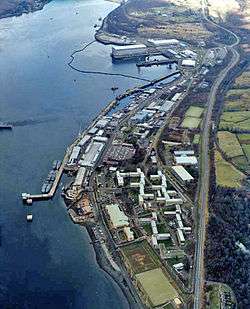
The Royal Navy currently operates from three bases in the United Kingdom where commissioned ships are based; Portsmouth, Clyde and Devonport, Plymouth—Devonport is the largest operational naval base in the UK and Western Europe.[132] Each base hosts a flotilla command under a commodore, or, in the case of Clyde, a captain, responsible for the provision of operational capability using the ships and submarines within the flotilla. 3 Commando Brigade Royal Marines is similarly commanded by a brigadier and based in Plymouth. Historically, the Royal Navy maintained Royal Navy Dockyards around the world.[133] Dockyards of the Royal Navy are harbours where ships are overhauled and refitted. Only four are operating today; at Devonport, Faslane, Rosyth and at Portsmouth.[134] A Naval Base Review was undertaken in 2006 and early 2007, the outcome being announced by Secretary of State for Defence, Des Browne, confirming that all would remain however some reductions in manpower were anticipated.[135]
The academy where initial training for future Royal Navy officers takes place is Britannia Royal Naval College, located on a hill overlooking Dartmouth, Devon. Basic training for future ratings takes place at HMS Raleigh at Torpoint, Cornwall, close to HMNB Devonport.[136]
Significant numbers of naval personnel are employed within the Ministry of Defence, Defence Equipment and Support and on exchange with the Army and Royal Air Force. Small numbers are also on exchange within other government departments and with allied fleets, such as the United States Navy. The navy also posts personnel in small units around the world to support ongoing operations and maintain standing commitments. Nineteen personnel are stationed in Gibraltar to support the small Gibraltar Squadron, the RN's only permanent overseas squadron. Some personnel are also based at East Cove Military Port and RAF Mount Pleasant in the Falkland Islands to support APT(S). Small numbers of personnel are based in Diego Garcia (Naval Party 1002), Miami (NP 1011 – AUTEC), Singapore (NP 1022), Dubai (NP 1023) and elsewhere.[137]
On 6 December 2014, the Foreign and Commonwealth Office announced it would expand the UK's naval facilities in Bahrain to support larger Royal Navy ships deployed to the Persian Gulf. Once complete, it will be the UK's first permanent military base located East of Suez since it withdrew from the region in 1971. The base will reportedly be large enough to accommodate Type 45 destroyers and Queen Elizabeth-class aircraft carriers.[138][139][140]
Titles and naming

Of the Navy
The navy of the United Kingdom is commonly referred to as the "Royal Navy" both in the United Kingdom and other countries. Navies of other Commonwealth countries where the British monarch is also head of state include their national name, e.g. Royal Australian Navy. Some navies of other monarchies, such as the Koninklijke Marine (Royal Netherlands Navy) and Kungliga Flottan (Royal Swedish Navy), are also called "Royal Navy" in their own language. The Danish Navy stands out with the term Royal incorporated in its official name (Royal Danish Navy), but only using the term "Flåden" (Navy) in everyday speech.[141] The French Navy, despite France being a republic since 1870, is often nicknamed "La Royale" (literally: The Royal).[142]
Of ships
Royal Navy ships in commission are prefixed since 1789 with Her Majesty's Ship (His Majesty's Ship), abbreviated to "HMS"; for example, HMS Beagle. Submarines are styled HM Submarine, also abbreviated "HMS". Names are allocated to ships and submarines by a naming committee within the MOD and given by class, with the names of ships within a class often being thematic (for example, the Type 23s are named after British dukes) or traditional (for example, the Invincible-class aircraft carriers all carry the names of famous historic ships). Names are frequently re-used, offering a new ship the rich heritage, battle honours and traditions of her predecessors. Often, a particular vessel class will be named after the first ship of that type to be built. As well as a name, each ship and submarine of the Royal Navy and the Royal Fleet Auxiliary is given a pennant number which in part denotes its role. For example, the destroyer HMS Daring (D32) displays the pennant number 'D32'.[143]
Ranks, rates, and insignia
The Royal Navy ranks, rates and insignia form part of the uniform of the Royal Navy. The Royal Navy uniform is the pattern on which many of the uniforms of the other national navies of the world are based (e.g. Ranks and insignia of NATO navies officers, Uniforms of the United States Navy, Uniforms of the Royal Canadian Navy, French Naval Uniforms).[144]
For officers (see also Royal Navy officer rank insignia):
| NATO code | OF-10 | OF-9 | OF-8 | OF-7 | OF-6 | OF-5 | OF-4 | OF-3 | OF-2 | OF-1 | OF(D) | Student officer | ||||||||||||||||||||||||||||||
|---|---|---|---|---|---|---|---|---|---|---|---|---|---|---|---|---|---|---|---|---|---|---|---|---|---|---|---|---|---|---|---|---|---|---|---|---|---|---|---|---|---|---|
(Edit) |
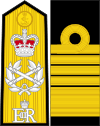 |
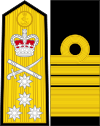 |
 |
 |
 |
 |
 |
 |
 |
 |
  |
No equivalent | ||||||||||||||||||||||||||||||
| Admiral of the Fleet | Admiral | Vice admiral | Rear admiral | Commodore | Captain | Commander | Lieutenant commander | Lieutenant | Sub lieutenant | Midshipman | Officer Cadet | |||||||||||||||||||||||||||||||
(Royal Marines) (Edit) |
 |
 |
 |
 |
 |
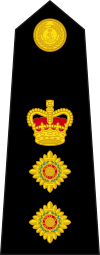 |
 |
 |
 |
 |
 |
.svg.png) |
No equivalent | |||||||||||||||||||||||||||||
| Captain General Royal Marines |
General | Lieutenant-general | Major-general | Brigadier | Colonel | Lieutenant-colonel | Major | Captain | Lieutenant | Second lieutenant | Officer cadet | |||||||||||||||||||||||||||||||
| NATO code | OF-10 | OF-9 | OF-8 | OF-7 | OF-6 | OF-5 | OF-4 | OF-3 | OF-2 | OF-1 | OF(D) | Student officer | ||||||||||||||||||||||||||||||
1 Rank in abeyance – routine appointments no longer made to this rank, though honorary awards of this rank are occasionally made to senior members of the Royal family and prominent former First Sea Lords.
For Enlisted rates (see also Royal Navy ratings rank insignia):
| NATO Code | OR-9 | OR-8 | OR-7 | OR-6 | OR-5 | OR-4 | OR-3 | OR-2 | OR-1 | |||||||||||||||||||||||||||
|---|---|---|---|---|---|---|---|---|---|---|---|---|---|---|---|---|---|---|---|---|---|---|---|---|---|---|---|---|---|---|---|---|---|---|---|---|
(Edit) |
 |
 |
 |
 |
No equivalent |  |
No equivalent |  |
No equivalent | |||||||||||||||||||||||||||
| Warrant officer class 1 | Warrant officer class 2 (phased out 2014) |
Chief petty officer | Petty officer | Leading seaman | Able seaman | |||||||||||||||||||||||||||||||
(Royal Marines) (Edit) |
 |
 |
 |
 |
No equivalent |  |
 |
No equivalent | No insignia | |||||||||||||||||||||||||||
| Warrant officer class 1 | Warrant officer class 2 | Colour sergeant | Sergeant | Corporal | Lance corporal | Marine | ||||||||||||||||||||||||||||||
| NATO Code | OR-9 | OR-8 | OR-7 | OR-6 | OR-5 | OR-4 | OR-3 | OR-2 | OR-1 | |||||||||||||||||||||||||||
Custom and tradition
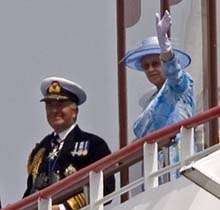
Traditions
The Royal Navy has several formal customs and traditions including the use of ensigns and ships badges. Royal Navy ships have several ensigns used when under way and when in port. Commissioned ships and submarines wear the White Ensign at the stern whilst alongside during daylight hours and at the main-mast whilst under way. When alongside, the Union Jack is flown from the jackstaff at the bow, and can only be flown under way either to signal a court-martial is in progress or to indicate the presence of an admiral of the fleet on-board (including the Lord High Admiral or the monarch).[145]
The Fleet Review is an irregular tradition of assembling the fleet before the monarch. The first review on record was held in 1400, and the most recent review as of 2009 was held on 28 June 2005 to mark the bi-centenary of the Battle of Trafalgar; 167 ships from many different nations attended with the Royal Navy supplying 67.[146]
"Jackspeak"
There are several less formal traditions including service nicknames and Naval slang, known as "Jackspeak".[147] The nicknames include "The Andrew" (of uncertain origin, possibly after a zealous press ganger)[148][149] and "The Senior Service".[150][151] British sailors are referred to as "Jack" (or "Jenny"), or more widely as “Matelots”. Royal Marines are fondly known as "Bootnecks" or often just as "Royals". A compendium of Naval slang was brought together by Commander A. Covey-Crump and his name has in itself become the subject of Naval slang; Covey Crump.[150] A game traditionally played by the Navy is the four-player board game known as "Uckers". This is similar to Ludo and it is regarded as easy to learn, but difficult to play well.[152]
Navy Cadets
The Royal Navy sponsors or supports three youth organisations:
- Volunteer Cadet Corps – consisting of Royal Naval Volunteer Cadet Corps and Royal Marines Volunteer Cadet Corps, the VCC was the first youth organisation officially supported or sponsored by the Admiralty in 1901.[153]
- Combined Cadet Force – in schools, specifically the Royal Navy Section and the Royal Marines Section.[154]
- Sea Cadets – supporting teenagers who are interested in naval matters, consisting of the Sea Cadets and the Royal Marines Cadets.[155]
The above organisations are the responsibility of the CUY branch of Commander Core Training and Recruiting (COMCORE) who reports to Flag Officer Sea Training (FOST).[156]
In popular culture
The Royal Navy of the 18th century is depicted in many novels and several films dramatising the voyage and mutiny on the Bounty.[157] The Royal Navy's Napoleonic campaigns of the early 19th century are also a popular subject of historical novels. Some of the best-known are Patrick O'Brian's Aubrey-Maturin series[158] and C. S. Forester's Horatio Hornblower chronicles.[159]
The Navy can also be seen in numerous films. The fictional spy James Bond is a commander in the Royal Naval Volunteer Reserve (RNVR).[160] The Royal Navy is featured in The Spy Who Loved Me, when a nuclear ballistic-missile submarine is stolen,[161] and in Tomorrow Never Dies when a media baron sinks a Royal Navy warship in an attempt to trigger a war between the UK and People's Republic of China.[162] Master and Commander: The Far Side of the World was based on Patrick O'Brian's Aubrey-Maturin series.[163] The Pirates of the Caribbean series of films also includes the Navy as the force pursuing the eponymous pirates.[164] Noël Coward directed and starred in his own film In Which We Serve, which tells the story of the crew of the fictional HMS Torrin during the Second World War. It was intended as a propaganda film and was released in 1942. Coward starred as the ship's captain, with supporting roles from John Mills and Richard Attenborough.[165]
C. S. Forester's Hornblower novels have been adapted for television.[166] The Royal Navy was the subject of an acclaimed 1970s BBC television drama series, Warship,[167] and of a five-part documentary, Shipmates, that followed the workings of the Royal Navy day to day.[168]
Television documentaries about the Royal Navy include: Empire of the Seas: How the Navy Forged the Modern World, a four-part documentary depicting Britain's rise as a naval superpower, up until the First World War;[169] Sailor, about life on the aircraft carrier HMS Ark Royal;[170] and Submarine, about the submarine captains' training course, 'The Perisher'.[171] There have also been Channel 5 documentaries such as Royal Navy Submarine Mission, following a nuclear-powered fleet submarine.[172]
The popular BBC radio comedy series The Navy Lark featured a fictitious warship ("HMS Troutbridge") and ran from 1959 to 1977.
See also
- List of ship names of the Royal Navy (a full historical list)
- Bibliography of 18th–19th century Royal Naval history
- Future of the Royal Navy
- Her Majesty's Coastguard
- The Royal British Legion
- The Royal Hospital School
Notes
- Since April 2013, Ministry of Defence publications no longer report the entire strength of the Regular Reserve; instead, only Regular Reserves serving under a fixed-term reserve contract are counted. These contracts are similar in nature to the Maritime Reserve.
- In Royal Navy parlance, "commissioned ships" invariably refers to both submarines and surface ships. Non-commissioned ships operated by or in support of Her Majesty's Naval Service are not included.
-
 1630–1707
1630–1707 Middle Ages – 1707
Middle Ages – 1707.svg.png) 1707–1800
1707–1800 -
 1545–1606
1545–1606.svg.png) Middle Ages – 1606
Middle Ages – 1606 1606–1800
1606–1800
References
- Tittler, Robert; Jones, Norman L. (15 April 2008). A Companion to Tudor Britain. John Wiley & Sons. p. 193. ISBN 9781405137409.
- "Quarterly Service Personnel Statistics" (PDF). Ministry of Defence. 1 April 2020. Retrieved 3 July 2020.
- "HMS Trent departs on her first deployment". Royal Navy. Retrieved 3 August 2020.
- Military Aircraft: Written question – 225369 (House of Commons Hansard) Archived 26 August 2016 at the Wayback Machine, parliament.uk, March 2015
- Rose, Power at Sea, p. 36
- Hyde-Price, European Security, pp. 105–106.
- "The Royal Navy: Britain's Trident for a Global Agenda". Henry Jackson Society. 4 November 2006. Archived from the original on 11 September 2016. Retrieved 4 November 2006.
Britannia, with her shield and trident, is the very symbol, not only of the Royal Navy, but also of British global power. In the last instance, the Royal Navy is the United Kingdom's greatest strategic asset and instrument. As the only other 'blue-water' navy other than those of France and the United States, its ballistic missile submarines carry the nation's nuclear deterrent and its aircraft carriers and escorting naval squadrons supply London with a deep oceanic power projection capability, which enables Britain to maintain a 'forward presence' globally, and the ability to influence events tactically throughout the world.
- Bennett, James C (2007). The Anglosphere Challenge: Why the English-speaking Nations Will Lead the Way in the Twenty-first Century. United States: Rowman & Littlefield. p. 286. ISBN 0742533336.
...the United States and the United Kingdom have the world's two best world-spanning blue-water navies... with the French being the only other candidate... and China being the most likely competitor in the long term
- Axe, David (10 August 2016). The Decline of the Royal Navy Archived 27 September 2017 at the Wayback Machine. Originally on Reuters. Retrieved 26 September 2017.
- Glaze, Ben (4 September 2017). Armed Forces recruitment crisis sees military "running to stand to still", warns report ordered by Downing Street Archived 7 September 2017 at the Wayback Machine. Mirror. Retrieved 26 September 2017.
- "What we do". Royal Navy. Archived from the original on 30 December 2017. Retrieved 30 December 2017.
- Childs, David (17 September 2009). Tudor Sea Power: The Foundation of Greatness. Seaforth Publishing. p. 298. ISBN 9781473819924.
- Rodger, N.A.M. (1998). The safeguard of the sea : a naval history of Britain, 660-1649 (1st American ed.). New York: W.W. Norton. ISBN 9780393319606.
- Rodger, Safeguard, pp. 52–53, 117–130.
- Swanton, p. 138.
- Swanton, pp. 154–165, 160–172.
- Stanton, Charles (2015). Medieval Maritime Wartime. South Yorkshire: Pen & Sword Maritime. pp. 225–226.
- Stanton, Charles D. (2015). Medieval Maritime Warfare. Pen and Sword. ISBN 978-1781592519.
- Michel, F. (1840). Historie des Dues de Normandie et des Rois d'Angleterre. Paris. pp. 172–177.
- Rodger, Safeguard, pp. 93–99.
- Rodger, Safeguard, pp. 91–97, 99–116, 143–144.
- P. F. Tytler, History of Scotland, Volume 2 (London: Black, 1829), pp. 309–310.
- P. J. Potter, Gothic Kings of Britain: the Lives of 31 Medieval Rulers, 1016–1399 (Jefferson, NC: McFarland, 2008), ISBN 0-7864-4038-4, p. 157.
- A. Macquarrie, Medieval Scotland: Kinship and Nation (Thrupp: Sutton, 2004), ISBN 0-7509-2977-4, p. 153.
- N. A. M. Rodger, The Safeguard of the Sea: A Naval History of Britain. Volume One 660-1649 (London: Harper, 1997) pp. 74-90.
- Childs, David (17 September 2009). Tudor Sea Power: The Foundation of Greatness. Seaforth Publishing. p. 298. ISBN 9781473819924.
- Rodger, Safeguard, pp. 221–237.
- Rodger, Safeguard, pp. 238–253, 281–286, 292–296.
- Rodger, Safeguard, pp. 379–394, 482.
- John Barratt, 2006, Cromwell's Wars at Sea. Barnsley, South Yorkshire; Pen & Sword; pp.
- Rodger, Command, pp. 2–3, 216–217, 607.
- Derrick, Charles (1806). "Memoirs of the rise and progress of the Royal Navy". Archived from the original on 30 December 2017. Retrieved 30 December 2017.
- Rodger, Command, pp. 142–152, 607–608.
- Rodger, Command, p. 608.
- Rodger, Command, pp. 291–311, 408–425, 473–476, 484–488.
- Rodger, Command, pp. 277–283.
- Rodger, Command, pp. 284–287.
- Rodger, Command, pp. 351–352.
- Parkinson, pp. 91–114; Rodger, Command, pp. 528–544.
- "How did Britain come to rule the waves?". History Extra. Archived from the original on 7 March 2019. Retrieved 6 March 2019.
- Sondhaus, p. 161.
- Brown, Paul (January 2017), "Building Dreadnought", Ships Monthly: 24–27
- "Distant Victory: The Battle of Jutland and the Allied Triumph in the First World War, page XCIV". Praeger Security International. July 2006. Retrieved 30 May 2016.
- "The Washington Naval Conference, 1921–1922". Office of the historian. Archived from the original on 29 December 2017. Retrieved 1 January 2018.
- "Respectful rebels: The Invergordon Mutiny and Granny's MI5 file". BBC. 20 December 2016. Archived from the original on 28 October 2018. Retrieved 1 January 2018.
- Abraham, Douglas A. (14 February 2019). Underwater Acoustic Signal Processing: Modeling, Detection, and Estimation. Springer. ISBN 978-3-319-92983-5.
- "Royal Navy in 1939 and 1945". Naval-history.net. 8 September 1943. Archived from the original on 1 September 2016. Retrieved 28 December 2011.
- "1939 – Navy lists". National Library of Scotland. Retrieved 21 February 2016.
- Baron, Scott; Wise, James E. (2004). Soldiers lost at sea: a chronicle of troopship disasters. Naval Institute Press. p. 100. ISBN 1-59114-966-5. Retrieved 29 October 2015.
- "Battle of the Atlantic". History Place. Retrieved 12 August 2020.
- Kennedy, 1989, pp. 570–571.
- "We were heading for war...and the Commons blamed me". The Daily Telegraph. London. 1 March 2002. Archived from the original on 18 July 2006. Retrieved 10 August 2007.
- "Has the time come to the move the cost of Trident replacement out of the MoD budget?". Save the Navy. 27 November 2017. Archived from the original on 31 December 2017. Retrieved 30 December 2017.
- John Ingham. "Royal Navy is now 'too small' to protect Britain". Express. Archived from the original on 23 October 2014. Retrieved 23 November 2014.
- "Welfate Officer". Royal Navy. Retrieved 9 May 2020.
- "First woman wins Marines' green beret". The Telegraph. 1 June 2002. Archived from the original on 9 August 2017. Retrieved 30 December 2017.
- "UK Armed Forces Monthly Personnel Report" (PDF). gov.uk. Ministry of Defence. 1 January 2015. p. 8. Archived (PDF) from the original on 2 April 2015.
- gov.uk MoD – quarterly personnel report Archived 21 April 2016 at the Wayback Machine, table 2, p. 7. 1 January 2015.
- dasa.mod – reserves and cadet strengths Archived 3 December 2013 at the Wayback Machine, table 2, p. 4. April 2012.
- dasa.mod – reserves and cadet strengths Archived 2 February 2014 at the Wayback Machine, table 2-page 12. See note 2. April 2013.
- gov.uk MoD – reserves and cadet strengths Archived 8 March 2016 at the Wayback Machine, table 2, p. 11. April 2014.
- "Strength of British military falls for ninth year". BBC News Online. 16 August 2019. Retrieved 18 August 2019.
- Ripley, Tim. "Admirals thrown to sharks as 'top-heavy' navy tries to cut costs". ISSN 0140-0460. Retrieved 11 May 2020.
- at 2:35pm, 23rd December 2019. "Royal Navy To Cut Back On Senior Personnel". Forces Network. Retrieved 11 May 2020.
- rose.slavin (6 December 2017). "The Commissioning Ceremony of HMS Queen Elizabeth". The Royal Family. Retrieved 2 January 2020.
- "Royal Navy arrives in British Virgin Islands bringing much-needed aid to the Hurricane Irma-ravaged territory". The Telegraph. 9 September 2017. Archived from the original on 31 December 2017. Retrieved 30 December 2017.
- "HMS Queen Elizabeth". royalnavy.mod.uk. Archived from the original on 7 December 2018. Retrieved 12 January 2018.
- "Queen Elizabeth Due To Set Sail From Rosyth today". BBC News. 26 June 2017. Archived from the original on 26 June 2017. Retrieved 26 June 2017.
- "Key facts about the Queen Elizabeth Class" (PDF). Aircraft Carrier Alliance. Archived (PDF) from the original on 28 July 2017. Retrieved 12 July 2017.
- "Iconic structure is installed on HMS Prince of Wales". Archived from the original on 2 July 2017. Retrieved 12 July 2017.
- "Commissioning day for HMS Prince of Wales". www.royalnavy.mod.uk. Retrieved 2 January 2020.
- "Royal Navy information". MOD. Archived from the original on 14 August 2007. Retrieved 10 August 2007.
- "The Fleet Welcomes HMS Duncan, The Sixth and Final Type 45 Destroyer". 26 September 2013. Archived from the original on 29 March 2014.
- Royal Navy: Type 45 Destroyer Archived 4 May 2014 at the Wayback Machine, 28 January 2014
- "Type 45 Destroyer". BAE Systems. Archived from the original on 15 October 2007. Retrieved 2 November 2007.
- Grafton became Almirante Lynch, Marlborough became Almirante Condell, Norfolk became Almirante Cochrane "Type 23 Duke class – Helicopter Database". helis.com. Archived from the original on 31 August 2016. Retrieved 23 March 2013.
- "Strategic Defence and Security Review – Securing Britain in an Age of Uncertainty" (PDF). Ministry of Defence. Archived from the original (PDF) on 22 December 2010. Retrieved 1 July 2011.
- "National Security Strategy and Strategic Defence and Security Review 2015" (PDF). gov.uk. Cabinet Office. 23 November 2015.
- "Echoes of a varied history – HMS Echo, ship of the month May 2004 (archive)". Navy News. Archived from the original on 19 July 2008. Retrieved 20 June 2009.
- "First steel cut on new patrol ships". Ministry of Defence. 10 October 2014. Archived from the original on 27 August 2016. Retrieved 11 October 2014.
The first of the new OPVs will be named HMS Forth and is expected to be handed over to the Royal Navy in 2017. The second will be named HMS Medway and the third HMS Trent.
- "£287M for two more Royal Navy ships as work begins on the next – News stories – GOV.UK". www.gov.uk. Archived from the original on 2 February 2017. Retrieved 24 January 2017.
- "HMS Forth Sets Sail For Falklands Deployment". Forces Network. 1 November 2019.
- "HMS Clyde's last drive home for Christmas". www.royalnavy.mod.uk. Retrieved 2 January 2020.
- "HMS Protector ready". Think Defence. 26 May 2011. Archived from the original on 13 February 2016. Retrieved 27 September 2013.
- "HMS Magpie (H130) | Royal Navy". www.royalnavy.mod.uk. Retrieved 2 January 2020.
- "Australia to buy used UK landing ship". Sydney Morning Herald. 6 April 2011. Archived from the original on 9 October 2016. Retrieved 9 September 2016.
- "Royal Navy unveils new Amphibious landing ships". Ministry of Defence. 6 October 2006. Archived from the original on 15 August 2007. Retrieved 10 August 2007.
- "Royal Navy Submarine School". Royal Navy. 10 April 2012. Archived from the original on 19 April 2012. Retrieved 2 March 2016.
- "MOD Awards £800m Contract For Submarine Propulsion Programme". Royal Navy. 13 February 2013. Archived from the original on 30 December 2017. Retrieved 30 December 2017.
- Knight, Will (5 December 2006). "UK unveils plans for a new submarine fleet". New Scientist (Environment). Archived from the original on 8 December 2008. Retrieved 10 August 2007.
- "Royal Navy to Get New Attack Submarine". Royal Navy. 21 May 2007. Archived from the original on 9 October 2007. Retrieved 10 October 2007.
- "HMS Artful commissioned in Royal Navy ceremony". Yorkshire Post. 19 March 2016. Archived from the original on 31 March 2016. Retrieved 19 March 2016.
- Securing Britain in an Age of Uncertainty: The Strategic Defence and Security Review Archived 27 September 2012 at the Wayback Machine direct.gov.uk
- "First UK fighter jets land onboard HMS Queen Elizabeth". UK Ministry of Defence. 13 October 2019. Retrieved 14 October 2019.
- "RAF chief opens state of the art helicopter training facilities in Shawbury/". Shropshire Star. Retrieved 9 May 2020.
- "UK MoD begins training helicopter acquisition". Flight Global. 10 September 2014. Archived from the original on 30 December 2017. Retrieved 30 December 2017.
- "HMS Queen Elizabeth to get first F-35 jets next year". UK Defence Journal. 26 April 2017. Archived from the original on 30 December 2017. Retrieved 30 December 2017.
- "UK sells 72 retired Harrier jump jets for $180m to US". BBC. 24 November 2011. Retrieved 10 April 2020.
- Royal Marines home page Archived 6 June 2013 at the Wayback Machine on Royal Navy website
- "Royal Marines". Royal Navy. Retrieved 9 May 2020.
- Paul, James; Spirit, Martin (2000). "The Special Boat Service". Britain's Small Wars Site Index. Archived from the original on 4 March 2010. Retrieved 9 March 2010.
- "Royal Marines train in Californian desert". Archived from the original on 18 October 2012. Retrieved 23 November 2014.
- "HMNB Devonport". Archived from the original on 8 January 2007.
- "HMNB Portsmouth". Royal Navy. Archived from the original on 30 December 2017. Retrieved 30 December 2017.
- "HMNB Clyde". Royal Navy. Archived from the original on 30 December 2017. Retrieved 30 December 2017.
- "Faslane Patrol Boat Squadron | Royal Navy". www.royalnavy.mod.uk. Retrieved 5 January 2020.
- "New Navy Wildcat Helicopter Squadron commissions at RNAS Yeovilton". Royal Naval Association. Retrieved 12 November 2019.
- "RNAS Culdrose | Royal Navy". www.royalnavy.mod.uk. Retrieved 12 November 2019.
- "New Royal Navy operations hub opens in Gulf". BIDEC 2019. Retrieved 13 November 2019.
- "Reborn Identity for Mine Countermeasure Squadron | Royal Navy". www.royalnavy.mod.uk. Retrieved 13 November 2019.
- "HMS Montrose to become first forward-deployed frigate in the Middle East | Royal Navy". www.royalnavy.mod.uk. Retrieved 13 November 2019.
- "Joint operations". Royal Navy. Archived from the original on 24 June 2007. Retrieved 7 August 2007.
- "Core Capabilities". Royal Navy. Archived from the original on 9 June 2007. Retrieved 7 August 2007.
- "HMS Forth". Royal Navy. Retrieved 9 May 2020.
- Cougar Archived 11 December 2010 at the Wayback Machine. Royal Navy. Retrieved on 18 September 2011.
- Ministry of Defence | Defence News | Training and Adventure | Royal Navy ready for unforeseen global events Archived 13 May 2011 at the Wayback Machine. Mod.uk (20 February 2007). Retrieved on 18 September 2011.
- Operations in the Gulf Archived 8 February 2011 at the Wayback Machine. Royal Navy. Retrieved on 18 September 2011.
- United Kingdom Component Command UKMCC Archived 8 February 2011 at the Wayback Machine. Royal Navy (15 June 2010). Retrieved on 18 September 2011.
- Commanding Officer Archived 8 February 2011 at the Wayback Machine. Royal Navy. Retrieved on 18 September 2011.
- "CTF – Iraqi Maritime". Archived from the original on 9 January 2011.
- Five Power Defence Arrangements (FPDA) Archived 14 March 2011 at the Wayback Machine. Ukinmalaysia.fco.gov.uk (3 March 2009). Retrieved on 18 September 2011.
- European Union Naval Force Somalia – Operation Atalanta Archived 6 May 2010 at the Wayback Machine. Eunavfor.eu. Retrieved on 18 September 2011.
- "New title for Duke of Edinburgh as he turns 90". BBC News. BBC. 10 June 2011. Archived from the original on 13 June 2011. Retrieved 10 June 2011.
- Parliament Archived 19 August 2016 at the Wayback Machine Speaker addresses Her Majesty Queen Elizabeth II, 20 March 2012 ["The daily example that You set, mirrored by our courageous armed forces of which You are Commander-in-Chief, is extraordinary."]
- MoD Website: people – First Sea Lord and Chief of Naval Staff Archived 22 November 2012 at the Wayback Machine, accessed 23 July 2013
- "Allied Maritime Command – Standing Forces". NATO. Archived from the original on 6 May 2016. Retrieved 8 May 2016.
- "Second Sea Lord". Royal Navy. Archived from the original on 10 June 2016. Retrieved 17 June 2016.
- "Senior Naval Staff". Archived from the original on 17 April 2014. Retrieved 23 November 2014.
- "Martin Connell" (PDF). Royal Navy. Retrieved 9 May 2020.
- "Defence Intelligence: Roles". Ministry of Defence. 12 December 2012. Archived from the original on 5 November 2014. Retrieved 4 November 2014.
- "HMNB Devonport". The Royal Navy. Archived from the original on 17 October 2007. Retrieved 18 October 2007.
- "Royal Navy Dockyards". National Maritime Museum. Archived from the original on 30 September 2007. Retrieved 10 August 2007.
- Vice-Admiral Sir Jeremy Blackham (13 March 2007). "The Royal Navy at the Brink" (PDF). 1. Royal United Services Institute. Archived from the original (PDF) on 10 July 2007. Retrieved 10 August 2007. Cite journal requires
|journal=(help) - "Devonport 'secure' says minister". BBC. 25 July 2007. Retrieved 10 August 2007.
- "HMS Raleigh: history". Royal Navy. Archived from the original on 17 September 2017. Retrieved 17 September 2017.
- British Forces Post Office – Ship/unit numbers Archived 17 May 2010 at the Wayback Machine 4 February 2011
- "UK-Bahrain sign landmark defence agreement". Foreign & Commonwealth Office. 5 December 2014. Archived from the original on 9 December 2014. Retrieved 6 December 2014.
- "UK to establish £15m permanent Mid East military base". BBC News. 6 December 2014. Archived from the original on 24 November 2017. Retrieved 6 December 2014.
- "East of Suez, West from Helmand: British Expeditionary Force and the next SDSR" (PDF). Oxford Research Group. December 2014. Archived from the original (PDF) on 2 July 2015. Retrieved 22 May 2015.
- most books on the subject of the Royal Danish Navy
- Randier, Jean (2006). La Royale : L'histoire illustrée de la Marine Nationale française. ISBN 978-2-35261-022-9.
- "HMS Daring". Royal Navy. Archived from the original on 13 September 2012. Retrieved 15 September 2012.
- "The French Navy and the Men Who Commanded It: Captains Who Served in the French Navy during the period 1791–1815". Napoleon Series. Archived from the original on 7 January 2018. Retrieved 30 December 2017.
- "Use of the Union Jack at Sea". Flags of the World. Archived from the original on 9 June 2007. Retrieved 14 July 2007.
- "French top gun at Fleet Review". The Times. London. 26 June 2005. Archived from the original on 29 June 2011. Retrieved 12 July 2007.
- "Sailors' Dictionary". Gun Plot. Retrieved 9 May 2020.
- Admiralty Manual of Seamanship. HMSO. 1964.
- "FAQs;Royal Navy's nickname". National Maritime Museum. Archived from the original on 29 June 2007. Retrieved 14 July 2007.
- Jolly, Rick. Jackspeak. Maritime Books Dec 2000. ISBN 0-9514305-2-1.
- "Naval Slang". Royal Navy. Archived from the original on 2 July 2007. Retrieved 14 July 2007.
- "The Basic Rules of Uckers". Archived from the original on 13 February 2009. Retrieved 12 September 2008.
- "History". Volunteer Cadet Corps. Archived from the original on 30 December 2017. Retrieved 30 December 2017.
- "Royal Navy". Combined Cadet Force. Archived from the original on 30 December 2017. Retrieved 30 December 2017.
- "History". Sea Cadets. Archived from the original on 30 December 2017. Retrieved 30 December 2017.
- "FOST Royal Navy". www.royalnavy.mod.uk. MOD, 2017. Archived from the original on 28 March 2017. Retrieved 18 March 2017.
- Mutiny on the Bounty on IMDb
- Lavery, Brian (2003). Jack Aubrey Commands: An Historical Companion to the Naval World of Patrick O'Brian. Conway Maritime. ISBN 0-85177-946-8.
- "Horatio Hornblower". National Maritime Museum. Archived from the original on 16 February 2016. Retrieved 9 February 2016.
- "25 things you probably didn't know about James Bond". IGN. Retrieved 30 December 2017.
- The Spy Who Loved Me on IMDb
- Tomorrow Never Dies on IMDb
- Master and Commander: The Far Side of the World on IMDb
- "Pirates of the Caribbean at IMDb". Archived from the original on 31 January 2018. Retrieved 20 July 2018.
- In Which we Serve on IMDb
- Hornblower: The Even Chance on IMDb
- "Warship". IMDB. Archived from the original on 16 April 2017. Retrieved 30 December 2017.
- "Devon Shipmates on TV". BBC. Archived from the original on 3 March 2006. Retrieved 19 July 2007.
- "Empire of the Seas: How the Navy Forged the Modern World". BBC. Archived from the original on 10 November 2017. Retrieved 30 December 2017.
- "Sailor". YouTube. Archived from the original on 7 November 2010. Retrieved 30 December 2017.
- "Perisher". YouTube. Retrieved 30 December 2017.
- "Royal Navy Submarine Mission". Channel 5. Archived from the original on 30 December 2017. Retrieved 30 December 2017.
Bibliography
- Beatson, Robert (1790). Naval and Military Memoirs of Great Britain, from 1727 to 1783. 3. Strachan. OCLC 937652092.
- Brown, D. K.; Moore, George (2012). Rebuilding the Royal Navy: Warship Design Since 1945. Seaforth. ISBN 9781848321502.
- Browning, Reed (1993). The War of the Austrian Succession. St. Martin's Press. ISBN 9780312094836.
- Chet, Guy (2014). The Ocean is a Wilderness: Atlantic Piracy and the Limits of State Authority, 1688-1856. University of Massachusetts Press. ISBN 978-1625340856.
- Clodfelter, Michael (2017). Warfare and Armed Conflicts: A Statistical Encyclopedia of Casualty and Other Figures, 1492–2015. McFarland & Co Inc. ISBN 9780786474707.
- Grimes, Shawn T. (2012). Strategy and War Planning in the British Navy, 1887–1918. Boydell. ISBN 9781846158179.
- Harding, Richard (2005). The Royal Navy 1930–2000: Innovation and Defence. Frank Cass. ISBN 9780203337684.
- Howard, David Armine (2003). British Sea Power: How Britain Became Sovereign of the Seas. Carroll & Graf. ISBN 9780786712496.
- Hyde-Price, Adrian (2007). European Security in the Twenty-First Century: The Challenge of Multipolarity. London: Routledge. ISBN 1134164408.
- Kennedy, Paul (1989). The Rise and Fall of Great Powers. London: Fontana. ISBN 9780049090194.
- Nelson, Arthur (2001). The Tudor navy: the ships, men and organisation, 1485–1603. Conway Maritime Press. ISBN 9780851777856.
- Potter, E. B. (1984). Sea Power: A Naval History. Naval Institute press. ISBN 9780870216077.
- Rodger, N.A.M. (1997). The Safeguard of the Sea: A Naval History of Britain, 660–1649. 1. Harper Collins. ISBN 9780006388401.
- Rodger, N.A.M. (2004). The Command of the Ocean: A Naval History of Britain, 1649–1815. 2. Penguin. ISBN 9780141026909.
- Rose, Lisle A. (2006). Power at Sea: The Breaking Storm, 1919–1945. 2. University of Missouri Press. ISBN 9780826216946.
- Simms, Brendan (2008). Three Victories and a Defeat: The Rise and Fall of the First British Empire. Penguin Books. ISBN 9780465013326.
- Sondhaus, Lawrence (2001). Naval Warfare, 1815–1914. New York: Routledge. ISBN 9780415214780.
- Stanton, Charles (2015). Medieval Maritime Wartime. South Yorkshire: Pen & Sword Maritime. pp. 225–226.
- Willmott, H. P. (2009). The Last Century of Sea Power, Volume 1: From Port Arthur to Chanak, 1894–1922. Indiana University Press. ISBN 9780253352149.
- Willmott, H. P. (2010). The Last Century of Sea Power, Volume 2: From Washington to Tokyo, 1922–1945. Indiana University Press. ISBN 9780253353597.
- Wilson, Ben (2013). Empire of the Deep: the rise and fall of the British Navy. Weidenfeld & Nicolson. ISBN 9780297864080.
- Winfield, R. (2007). British Warships of the Age of Sail 1714–1792: Design, Construction, Careers and Fates. Seaforth. ISBN 9781844157006.
External links
| Wikimedia Commons has media related to Royal Navy. |
| Wikisource has original text related to this article: |
- Official website

- History of the Royal Navy
- Sea Your History – Royal Naval Museum
- Royal Marines Museum
- List of sunken ships of the Royal Navy on the wrecksite
- Navy News – Royal Navy Newspaper
